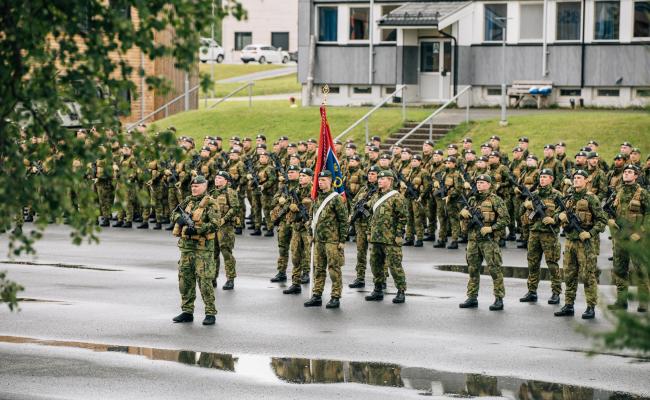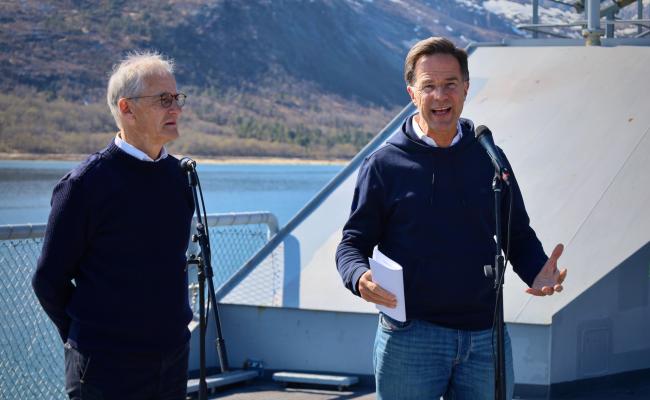Norway's New High North Strategy: "A Serious Backdrop"
In the Arctic Strategy, the government outlines the direction for further policy for the region, which is described as Norway's number one foreign policy priority. From left: Bjørnar Skjæran, leader of the Labor Party's parliamentary group, Minister of Transport Jon-Ivar Nygård, and State Secretary Maria Varteressian at the Ministry of Foreign Affairs. (Photo: Trine Jonassen / High North News).
Bodø, Northern Norway (High North News): "We need to think differently about how we cooperate north in the Nordic region, but also circumpolar, to be safer," said MFA State Secretary Maria Varteressian in connection with the launch of a new High North strategy. A strategy with a serious security policy backdrop, says researcher Andreas Østhagen.
"This is about the state of the realm and security," said the Ministry of Foreign Affairs' State Secretary, Maria Varteressian, about the High North policy in an interview with High North News.
We met with Varteressian in Bodø on Tuesday during the launch of the Norwegian government's new High North strategy. It was presented in the cities of Kirkenes, Tromsø, and Bodø.
The strategy does not provide an exhaustive list of the government's measures and efforts in the High North, but lays the foundation for the work in the years ahead. The government will follow up on this guiding strategy with concrete priorities in the upcoming budget processes and in other policy developments, the strategy states. (Photo: Trine Jonassen / High North News)
Norway in the North. Arctic Policy in a New Reality [ed. translation] is the name of the new strategy, which replaces the previous one by the Solberg Cabinet in 2017.
The geopolitical situation today is of an entirely different kind, with geopolitical upheaval, war in Europe, and climate change, which has strengthened the interest in, and pressure on, the High North, reads the strategy.
"When our surroundings change, we must adjust our policy," it furthermore states.
Also read (arcticle continues below)
"Not an exhaustive list"
In the new document, the government highlights five areas of priority, which will form the basis of the Government’s High North policy going forward:
- Norwegian freedom of action and influence in the High North
- Total defence that ensures security, activity and preparedness in the north
- Safe and thriving local communities
- Infrastructure that builds communities
- Business development that creates value
We asked Varteressian what she considers the most important aspect of the new strategy.
"One of the most important aspects is that we are connecting the billion investment in the Armed Forces, research and preparedness with societal development, where we see several needs in context. We look at what is needed to create viable communities in the North. This is significant for the country as a whole."
The state secretary is clear that the strategy is to function as a compass, a working document, and is by no means an exhaustive list.
"We will be using this actively in the entire MFA, and other investments will come on top of this," she said, referring a.o. to the NOK 1 billion to polar research, among other things.
"The key has been to design a document that covers a wide spectrum, but which also is clear in its priorities," she added.
"Need to think differently"
How does this strategy differ from the previous strategy from 2017?
"The description of Russia, in particular," said Varteressian, referring to the previous close cooperation that characterized the relationship with Russia in the North.
"In this document, a starting point is Russia being the biggest security policy threat to Europe since World War 2. We need to think differently about how to cooperate north in the Nordic region, in NATO, but also circumpolar, in order to be more secure."
State Secretary Maria Varteressian and Minister of Transport Jon-Ivar Nygård during the launch of the High North Strategy in Bodø, Northern Norway. (Photo: Trine Jonassen)
Northern Nordic focus
How prominent is the cooperation with Sweden and Finland in this strategy?
"This is one of our foremost priorities and we call it the Northern Nordic cooperation. The Northern Nordic dimension can be found in the five areas of priority (see fact box)," she said and continued:
"The MFA will also have a dedicated resource who will work on Northern Nordic projects. There will be a strong focus on the political and on collaboration with our Finnish and Swedish collegues."
"The expansion of NATO in the Nordic region and a closer operational cooperation with our neighboring countries entail a need for increased military mobility in the North, and the government has strengthened the Nordic cooperation in the infrastructure and defense sectors, reads the High North Strategy. Photo of the Norwegian Minister of Transport Jon-Ivar Nygård. (Photo: Trine Jonassen / High North News)
Focus on East-West connections
The Norwegian Minister of Transport, Jon-Ivar Nygård, was also present in Bodø. He elaborated on the strategy's infrastructure dimension. He also points to the deepened cooperation with Sweden and Finland in this area.
"The investment in transport and infrastructure is based on the National Transport Plan (NTP). It has a clear focus on East-West connections, which are pointed out as important for military mobility, among other things. The Ofoten Line [between Norway and Sweden in the north, ed.note] is one of the prime examples," said Nygård and added:
"Significant investments are also happening in roads and infrastructure in the northern region, with the Hålogaland road, the E6 project between Megården and Sommerset, and with two airports in Mo i Rana and Bodø. In addition, new projects will arise via the National Transport Plan."
Also read (only in norwegian. the article continues below)
Civil and military needs
Does the strategy include any new measures for the Ofoten Line specifically?
"The National Transport Plan includes plans for the building of three new passing loops. This has been signalled to Bane NOR and they plan accordingly. In addition, the axle load limit is expanded to 32,5 tonnes so that the line can withstand more weight and dimensions. This is important to the Armed Forces," he explained.
"In addition, it is important for us to deepen and develop the cooperation with our Nordic colleagues even more. We have a cooperation between agencies across country borders. There is cooperation between us ministers, and we have instituted the civil services in the respective countries to explore how we can create a joint strategy to develop border-crossing corridors."
Varteressian also points out the significance of the infrastructure cooperation between Sweden and Finland in connection with the investment in defense, security, and preparedness.
"This strategy comes on top of other important guiding political documents, such as the National Security Strategy and the National Transport Plan, in which both ambitions and needs are to be seen in the context of both the military and the civilian."
A serious strategy

“The strategy does not contain anything shocking, but that is not the purpose either,” comments Andreas Østhagen, Research Director Arctic and Ocean Politics at the Fridtjof Nansen Institute. He is also a researcher at the High North Center at Nord University. (Photo: FNI).
Andreas Østhagen, the Research Director of Arctic and Ocean Politics at the Fridtjof Nansen Institute, notes the grave backdrop of the High North Strategy.
"This impacts the entire strategy and is clear in many of the prioritized areas: defense and security policy is the driver. It is an interesting turn, which is obviously natural, but it is still a shift compared to earlier documents, such as the previous Arctic white paper," says Østhagen to HNN.
"In my opinion, this is an High North Strategy with a much more serious tone than what we have seen before. It contains a lesser focus on traditional topics such as international cooperation and the Arctic Council. Now, the focus is more on the regional. Among other things, the County Council is highlighted as a central player," he continues, referring to the increased focus on collaboration with Sweden and Finland.
"There are also some specific measures. A lot revolves around stimulating everything from business growth to stopping depopulation and managing the population situation in Troms and Finnmark. Whether this is enough, and whether a lot has already been done or would be carried out anyway, is hard to say."
More about the five prioritized areas
The strategy highlights five priority areas that will form the basis of the Government’s High North policy going forward. The goal of the strategy is for Northern Norway to have vibrant local communities where people want to live, and that contribute to Norwegian security and preparedness. The five priority areas are:
- Norwegian freedom of action and influence in the High North: We will strengthen our defence capabilities and cooperation with Nordic allies, the United States, Canada and key European allies. We will ensure that allied presence in the north is well adapted to Norwegian conditions and anchored in Norwegian situational awareness. We will continue to invest in knowledge-building in the north and about the north.
- Total defence that ensures security, activity and preparedness in the north: We will facilitate positive ripple effects for local and regional businesses and societal development linked to enhanced defence efforts in the north. We will strengthen civil society’s preparedness capacity and competence.
- Safe and thriving local communities: People shall have access to good public services, to housing adapted to different life situations and to varied cultural and leisure offerings. We want people to be able to pursue their education where they live and work, and to make use of opportunities in digitalisation and new technology.
- Infrastructure that builds communities: We will prioritise measures that strengthen preparedness, settlement and business development. We will enhance mobility across borders in the north and invest in infrastructure that supports our overall preparedness.
Business development that creates value: We will support industrial development, economic activity that builds local communities and jobs, and industries that ensure preparedness and security of supply.
Source: The Norwegian Government.








